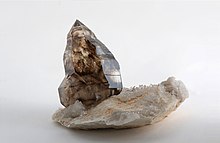Quartz is the second most abundant mineral in the Earth's continental crust, after feldspar. It is made up of a continuous framework of SiO4 silicon–oxygen tetrahedra, with each oxygen being shared between two tetrahedra, giving an overall formula SiO2.
There are many different varieties of quartz, several of which are semi-precious gemstones. Especially in Europe and the Middle East, varieties of quartz have been since antiquity the most commonly used minerals in the making of jewelry and hardstone carvings.
The word "quartz" is derived from the German word "quarz", which was imported from Middle High German, "twarc", which originated in Slavic (cf. Czech tvrdy ("hard"), Polish twardy ("hard"), Russian твёрдый ("hard")), from Old Church Slavonic тврьдъ ("firm"), from Proto-Slavic *tvьrdъ.
Citrine is a variety of quartz whose color ranges from a pale yellow to brown. Natural citrines are rare; most commercial citrines are heat-treated amethysts or smoky quartzes. It is nearly impossible to tell cut citrine from yellow topaz visibly, but they differ in hardness. Citrine has ferric impurities, and is rarely found naturally. Brazil is the leading producer of citrine, with much of its production coming from the state of Rio Grande do Sul. The name is derived from Latin citrina which means "yellow" and is also the origin of the word "citron." Sometimes citrine and amethyst can be found together in the same crystal and is referred to as ametrine.
Citrine is one of three traditional birthstones for the month of November.
Rose quartz is a type of quartz which exhibits a pale pink to rose red hue. The color is usually considered as due to trace amounts of titanium, iron, or manganese, in the massive material. Some rose quartz contains microscopic rutile needles which produces an asterism in transmitted light. Recent X-ray diffraction studies suggest that the color is due to thin microscopic fibers of possibly dumortierite within the massive quartz.
In crystal form (rarely found) it is called pink quartz and its color is thought to be caused by trace amounts of phosphate or aluminium. The color in crystals is apparently photosensitive and subject to fading. The first crystals were found in a pegmatite found near Rumford, Maine, USA, but most crystals on the market come from Minas Gerais, Brazil.
Rose quartz is not popular as a gem – it is generally too clouded by impurities to be suitable for that purpose. Rose quartz is more often carved into figures such as people or hearts. Hearts are commonly found because rose quartz is pink and an affordable mineral
Amethyst is a popular form of quartz that ranges from a bright to dark or dull purple color.
Smoky quartz is a gray, translucent version of quartz. It ranges in clarity from almost complete transparency to a brownish-gray crystal that is almost opaque. Some can also be black.
Milk quartz or milky quartz may be the most common variety of crystalline quartz and can be found almost anywhere. The white color may be caused by minute fluid inclusions of gas, liquid, or both, trapped during the crystal formation. The cloudiness caused by the inclusions effectively bars its use in most optical and quality gemstone applications.
Reff >>






















0 comments:
Post a Comment